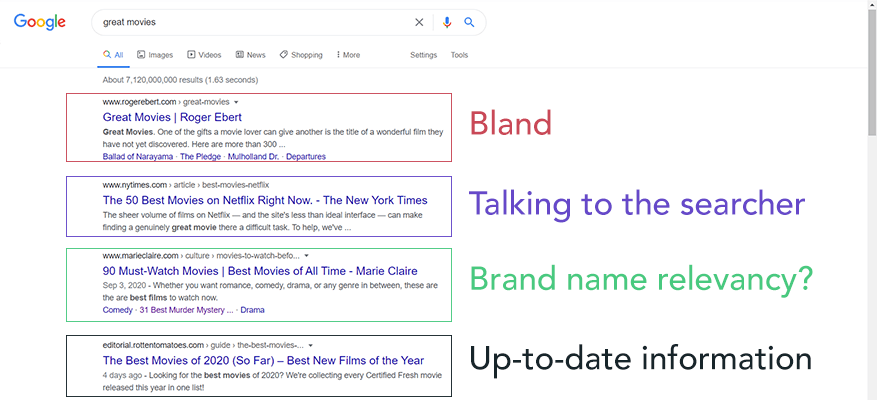The main goal of all SEO activity is to drive more traffic to your site, plain and simple. Digital marketers often lose sight of this when planning their SEO strategy by over-focusing on reaching the #1 search position for their targeted keyword. Now, we’re not saying reaching the top spot isn’t something to strive for, it most certainly is. But there’s a way to drive more traffic to your site without increasing your search position, and that’s through SEO title tag optimisation.
To put it simply, the goal of SEO title tag optimisation is to steal clicks away from the pages currently above your page in Google’s (and other search engines) rankings. When done correctly across all of your pages it has the power to boost your click-through-rate and organic traffic exponentially. Before explaining how to do that let’s clear up some quick questions on title tags.
What are title tags?
A title tag is the external name of a webpage. It’s the text that will be displayed whenever the page is shared or posted anywhere on the internet. It is also known as a page title or SEO title.
Where do title tags appear?
You will most commonly see title tags appear in 3 places. Firstly, in search engine results pages. This is the enlarged blue text Google displays for each result. Secondly, on social media. Every URL shared comes with a snippet of the page title. Lastly, in the tabs of your web browser, so that you can identify each page you’re currently looking at. If you are operating a store, your title tag strategy will differ and requires slightly different attention and strategy (see E-commerce SEO)
What is a good title tag length?
Under 60 characters is Google’s recommendation. Any more than this and Google will clip the text, which can possibly lead to your title not making sense to searchers and ruining your click-through-rate.
Every time your page appears in a Google search it’s competing with several other pages for the searcher’s attention. The most eye-grabbing component of any Google search is the page title, with it’s enlarged text and different colour. Title tags are written by you, this is your chance to get your page noticed by appealing directly to the searcher.
How to write title tags that stand out to searchers
When optimising your title tag the key is to make it appear visually distinctive. It needs to stand-out and grab the searcher’s attention away from pages that rank above yours. Below is a screengrab from a recent Google search on “great movies”. This search is a great example of how SEO title tag optimisation can drive more traffic to your page without having the #1 position. Why? Because Roger Elbert’s title tag is easily the most boring and least captivating on the page.

Here’s how to make your page title stand out from the rest:
Use numbers in your title
Numbers are an excellent way to catch the searcher’s attention whilst conveying information quickly and effectively. Look at the #2 position in the screengrab above, which title grabs your attention more?
- The fifty best movies on Netflix right now OR
- The 50 best movies on Netflix right now
Talk to your audience
Be direct and reassure the searcher that your page contains all of the information they’re looking for, nobody wants to waste their time on a webpage that might be irrelevant to them. By effectively communicating what content is on your page you can easily boost your click-through-rate.
Including your brand name
Should you include your brand name in your SEO title or not? This is a tricky question. On the one hand, yes, it’s good to get your brand name out there to build more awareness. On the other hand, you need to decide whether it brings any added incentive to the searcher to click on your URL. Ultimately, you only have 60 characters to play with and it could be taking up prime real estate.
A good rule of thumb is:
- If you’re talking about your product or services, include your brand name. It’s best to let potential clients know who you are.
- If your goal is to attract as many visitors to your site as possible, focus on writing a title that has all the key information your searcher needs and will make them want to click on your page.
Dates & brackets
Nobody wants to read outdated content. Letting the searcher know that your page contains up-to-date information and statistics is a great way to attract more clicks to your SEO title. An excellent way to do this is to include [Updated for 2020] or [2020 edition] in your title tag.
Symbols and emojis
This one we’ll leave at your discretion. An emoji will definitely make your webpage stand-out but it could come across as unprofessional. The key considerations here are your target audience and your brand voice.
Conclusion
Optimising your SEO title tag will undoubtedly increase your click-through-rate and drive more organic traffic to your website. Which method will work best depends on your business and niche. It’s important to continually monitor and A/B test your page titles to get the best results. Once you know which tactic works best you can scale that method across your entire site.
If you’d like to learn more about SEO title tag optimisation and how we can use it to drive more traffic to your business, you can view our SEO services here or contact us all about your project here.




